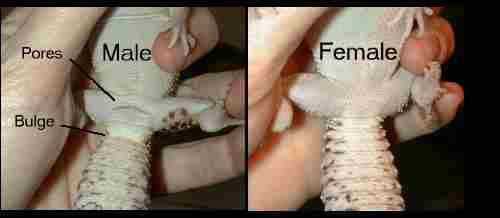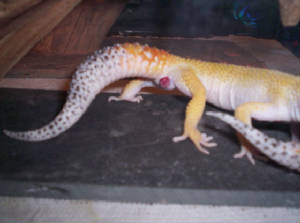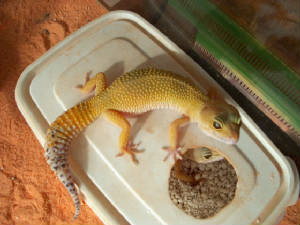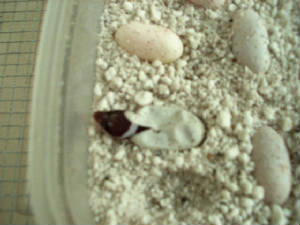|
OK, Breeding Leopard Geckos is relatively easy, however there are a few things you should know before you just throw
some geckos in together and let them "get busy."
Male or Female?
You should definitely know the sex of your leo before you start any introductions. Males should never be housed together
because they will fight very aggressively. However, one male can be housed with several females, provided there is enough
space for them all. I usually advise a minimum of one leo for every 10 gallons of space. If you don't know how to sex your
leo, have an experienced herper help you out for the first few times. You will learn to identify the hemipenal bulges
and anal pores of the males after some practice.
| Sexing your Leopard Gecko |

|
Cycling/Preparation
The old feed & breed saying is not far from the truth with leos. Although you should only select large healthy females
with big, fat tails for breeding. I never breed any female before she is 55 grams and loaded with calcium. Actually, I have
calcium available to all of my geckos at all times, but gravid females need extra calcium supplementation. Most Leopard Geckos
also require at least a short "cycling" or cooling period of about a month or two before heavy breeding activity will occur.
More current research suggests that perhaps the most important pre-season conditioning relates to the photoperiod. A few weeks
before I start my geckos breeding season, I increase the amount of "daylight" they receive to about 16 hours. this really
seems to get the males fired-up (no pun intended) and ready to go.
Breeding Behavior
The males are usually the first to start the breeding behavior. They will start by being more aggressive toward
the females. This may include some biting of the tail and neck of the girls. The males will also "rattle" their tail like
a rattlesnake and chase the females around the enclosure. This will continue until the female becomes receptive to the
males advances. She will then start to entice him by swaying her tail slowly in the air, after which he will mount her, and
place the base of his tail under hers so he may insert his hemipenis into her cloacal opening. ( As shown in the picture).
After a short period of time he will transfer his sperm and they will separate, upon which time he may clean his still protruding
hemipenis. (As shown in the picture). They will likely repeat this daily until the female becomes gravid, when she will be
less likely to entice the male. Once gravid, the females will usually lay 2 eggs about every 2-4 weeks.
| Two Mating Leopard Geckos |

|
| Male Hemipenis |

|
Egg Laying
Once you suspect the female is gravid you should provide her with an egg deposit box, for she will be looking for
a place to lay them. I use a small tupperware container with a hole cut in it so the females can easily get in and
out. The substrate should consist of moist perlite or vermiculite deep enough so the females can bury the eggs. You will notice
when she lays the eggs because the two lumps will be gone. After the eggs have been laid, CAREFULLY remove them from
the container and place them into their incubation medium without turning them at all. They should be transported in the same
position that they were laid. The incubation medium should consist of equal parts by weight of water and perlite or vermiculite
in a sealed tupperware container. At this time you should feed your hungry gecko.
| Females egg laying box |

|
Incubation
THe eggs should be incubated between 80-88 degrees F. Just remember that Leopard Geckos have temperature-dependant
(not genetically determined) sex, with lower temps of 80-83 degrees giving mostly females and 87-88 degrees giving
mostly males. The ideal temp for a 50/50 mix is 85 degrees. Also, if temps go over 89-90 degrees, the geckos that live
will usually be overly aggressive, infertile super-females. The incubation period varies with the incubation temperature,
with higher temps being faster, but average about 55 days at 85 degrees.
| Hatchling emerging from egg incubation container! |

|
Hatchlings
Once the babies hatch-out, you should remove them into their own enclosure so they do not disturb
any other eggs. After a few days to a week they will have their first shed. They should not be offered food until they have
done this. Congratulations! You just bred your first Leos.
Remember, these are only the basics! I highly reccommend that before trying your hand at breeding
Leos, you read books on the topic. Good Luck and Happy Herping!
|

